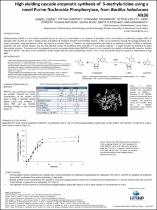 ResearchSpace
ResearchSpace
High yielding cascade enzymatic synthesis of 5-methyluridine using a novel Purine Nucleoside Phosphorylase, from Bacillus halodurans Alk36
JavaScript is disabled for your browser. Some features of this site may not work without it.
- ResearchSpace
- →
- Research Publications/Outputs
- →
- Conference Publications
- →
- View Item
| dc.contributor.author |
Vissser, D

|
|
| dc.contributor.author |
Hennessy, F

|
|
| dc.contributor.author |
Rashamuse, K

|
|
| dc.contributor.author |
Van Zyl, P

|
|
| dc.contributor.author |
Gordon, G

|
|
| dc.contributor.author |
Mathiba, K

|
|
| dc.contributor.author |
Bode, M

|
|
| dc.contributor.author |
Pletschke, B

|
|
| dc.contributor.author |
Brady, D

|
|
| dc.date.accessioned | 2010-09-28T12:34:32Z | |
| dc.date.available | 2010-09-28T12:34:32Z | |
| dc.date.issued | 2010-09 | |
| dc.identifier.citation | Vissser, D, Hennessy, F, Rashamuse, K et al. 2010. High yielding cascade enzymatic synthesis of 5-methyluridine using a novel Purine Nucleoside Phosphorylase, from Bacillus halodurans Alk36. 5th International Congress on Biocatalysis, Hamburg University of Technology, Germany, August 29-September 2, 2010, pp 1 | en |
| dc.identifier.uri | http://hdl.handle.net/10204/4384 | |
| dc.description | 5th International Congress on Biocatalysis, Hamburg University of Technology, Germany, August 29-September 2, 2010 | en |
| dc.description.abstract | 5-Methyluridine(5-MU) is a non-natural nucleoside that can be used as an intermediate in the synthesis of thymidine, and in the synthesis of nucleoside analogues AZT and stavudine, both of which are used in Highly Active Anti-Retroviral Treatment (HAART) of HIV/AIDS patients. 5-MU can be synthesised through the transglycosylation of D-ribose-1-phosphate, using guanosine as a donor, and thymine as receptor. However,the reagents guanosine and thymine are relatively insoluble, resulting in particulate substrates with poor reaction kinetics, and the most effective method of solubilising these materials is in hot aqueous solutions. It would therefore be preferable to utilize thermostable enzymes. The present work investigated the purine nucleoside phosphorylase (BHPNP1) present in the moderately thermophilic and alkaliphilic organism, Bacillus halodurans Alk361,2. The authors report on the combination of that enzyme with the uridine phosphorylase from E.coli in a one-pot cascade reaction to produce 5-methyl uridine in high yield. | en |
| dc.language.iso | en | en |
| dc.publisher | biocat2010 | en |
| dc.subject | 5-Methyluridine | en |
| dc.subject | Biocatalysis | en |
| dc.subject | Purine nucleoside phosphorylas | en |
| dc.subject | Highly active anti-retroviral treatment | en |
| dc.subject | HAART | en |
| dc.subject | Bacillus halodurans Alk36 | en |
| dc.subject | HIV | en |
| dc.subject | AIDS | en |
| dc.title | High yielding cascade enzymatic synthesis of 5-methyluridine using a novel Purine Nucleoside Phosphorylase, from Bacillus halodurans Alk36 | en |
| dc.type | Conference Presentation | en |
| dc.identifier.apacitation | Vissser, D., Hennessy, F., Rashamuse, K., Van Zyl, P., Gordon, G., Mathiba, K., ... Brady, D. (2010). High yielding cascade enzymatic synthesis of 5-methyluridine using a novel Purine Nucleoside Phosphorylase, from Bacillus halodurans Alk36. biocat2010. http://hdl.handle.net/10204/4384 | en_ZA |
| dc.identifier.chicagocitation | Vissser, D, F Hennessy, K Rashamuse, P Van Zyl, G Gordon, K Mathiba, M Bode, B Pletschke, and D Brady. "High yielding cascade enzymatic synthesis of 5-methyluridine using a novel Purine Nucleoside Phosphorylase, from Bacillus halodurans Alk36." (2010): http://hdl.handle.net/10204/4384 | en_ZA |
| dc.identifier.vancouvercitation | Vissser D, Hennessy F, Rashamuse K, Van Zyl P, Gordon G, Mathiba K, et al, High yielding cascade enzymatic synthesis of 5-methyluridine using a novel Purine Nucleoside Phosphorylase, from Bacillus halodurans Alk36; biocat2010; 2010. http://hdl.handle.net/10204/4384 . | en_ZA |
| dc.identifier.ris | TY - Conference Presentation AU - Vissser, D AU - Hennessy, F AU - Rashamuse, K AU - Van Zyl, P AU - Gordon, G AU - Mathiba, K AU - Bode, M AU - Pletschke, B AU - Brady, D AB - 5-Methyluridine(5-MU) is a non-natural nucleoside that can be used as an intermediate in the synthesis of thymidine, and in the synthesis of nucleoside analogues AZT and stavudine, both of which are used in Highly Active Anti-Retroviral Treatment (HAART) of HIV/AIDS patients. 5-MU can be synthesised through the transglycosylation of D-ribose-1-phosphate, using guanosine as a donor, and thymine as receptor. However,the reagents guanosine and thymine are relatively insoluble, resulting in particulate substrates with poor reaction kinetics, and the most effective method of solubilising these materials is in hot aqueous solutions. It would therefore be preferable to utilize thermostable enzymes. The present work investigated the purine nucleoside phosphorylase (BHPNP1) present in the moderately thermophilic and alkaliphilic organism, Bacillus halodurans Alk361,2. The authors report on the combination of that enzyme with the uridine phosphorylase from E.coli in a one-pot cascade reaction to produce 5-methyl uridine in high yield. DA - 2010-09 DB - ResearchSpace DP - CSIR KW - 5-Methyluridine KW - Biocatalysis KW - Purine nucleoside phosphorylas KW - Highly active anti-retroviral treatment KW - HAART KW - Bacillus halodurans Alk36 KW - HIV KW - AIDS LK - https://researchspace.csir.co.za PY - 2010 T1 - High yielding cascade enzymatic synthesis of 5-methyluridine using a novel Purine Nucleoside Phosphorylase, from Bacillus halodurans Alk36 TI - High yielding cascade enzymatic synthesis of 5-methyluridine using a novel Purine Nucleoside Phosphorylase, from Bacillus halodurans Alk36 UR - http://hdl.handle.net/10204/4384 ER - | en_ZA |





